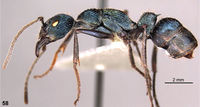Diacamma caeruleum
| Diacamma caeruleum | |
|---|---|

| |
| Scientific classification | |
| Kingdom: | Animalia |
| Phylum: | Arthropoda |
| Class: | Insecta |
| Order: | Hymenoptera |
| Family: | Formicidae |
| Subfamily: | Ponerinae |
| Tribe: | Ponerini |
| Genus: | Diacamma |
| Species: | D. caeruleum |
| Binomial name | |
| Diacamma caeruleum Laciny, Pal & Zettel, 2015 | |
Little is known about the biology of Diacamma caeruleum.
| At a Glance | • Gamergate |
Identification
Laciny et al. (2015) - Large species (TL 12.3–14.0 mm). Trunk with strong blue metallic shimmer. Mandibles and legs blackish. Long setae abundant; fine pilosity reduced. Trunk strongly striate from genae to gaster tergite 1. Head short, sides posteriorly of eye strongly convex. Posterior of head longitudinally striate until narrowly truncated hind margin; occipital margin ventrally terminating in short, blunt teeth. Eyes rather small. Clypeus medially smooth and shiny, apex sharp, blunt. Mandible with obliterate striation. Pronotum with transverse-elliptical rugae. Striation on propodeum horizontal. Petiole very stout, its teeth relatively short and narrow; subpetiolar process shallowly concave between acute anterior and posterior corners. Gaster tergite 1 with coarse semi-circular striation.
Diacamma caeruleum is a large, metallic blue species of the Diacamma rugosum group. It is similar to Diacamma viridipurpureum and Diacamma generali. From D. viridipurpureum viridipurpureum and D. generali, but not from Diacamma viridipurpureum quezonicum, it can immediately be distinguished by strong blue iridescence. The clypeus of D. caeruleum has a strongly shiny, unpunctured midline and a blunt, but acute-angled apex, whereas the clypeus of D. generali is densely punctured and the clypeus of D. viridipurpureum is apically rounded. Moreover, in D. caeruleum the striation of the mandible is reduced.
Morphometric characters distinguishing D. caeruleum from similar species are its relatively broad petiole and smaller eyes compared to both subspecies of Diacamma viridipurpureum (EI 24–26 vs. 25–28) as well as longer petiolar spines compared to D. generali (SpLI 24–31vs. 15–27).
Distribution
Only known from the type locality in a hilly area in eastern Mindoro.
Distribution based on Regional Taxon Lists
Indo-Australian Region: Philippines (type locality).
Distribution based on AntMaps
Distribution based on AntWeb specimens
Check data from AntWeb
Countries Occupied
| Number of countries occupied by this species based on AntWiki Regional Taxon Lists. In general, fewer countries occupied indicates a narrower range, while more countries indicates a more widespread species. |

|
Estimated Abundance
| Relative abundance based on number of AntMaps records per species (this species within the purple bar). Fewer records (to the left) indicates a less abundant/encountered species while more records (to the right) indicates more abundant/encountered species. |

|
Biology
Castes
Nomenclature
The following information is derived from Barry Bolton's Online Catalogue of the Ants of the World.
- caeruleum. Diacamma caeruleum Laciny, Pal & Zettel, 2015: 128, figs. 58-63 (w.) PHILIPPINES (Mindoro I.).
Unless otherwise noted the text for the remainder of this section is reported from the publication that includes the original description.
Description
Worker
holotype: TL 13.50; HW 2.38; HL 3.07; EL 0.60; SL 3.39; PH 2.02; PL 1.28; PW 1.47; SpD 0.67; SpL 0.42; WL 4.57; MTL 2.64. Indices: CI 78; SI 142; PI 63; SpDI 46; SpLI 29; EI 25. Measurements of paratypes (n = 10): TL 12.33–13.96; HW 2.20–2.46; HL 2.87–3.20; EL 0.56–0.63; SL 3.07–3.52; PH 1.83–2.07; PL 1.17–1.35; PW 1.33–1.54; SpD 0.58–0.71; SpL 0.36–0.46; WL 4.30–4.96; MTL 2.45–2.77. Indices: CI 74–78; SI 139–148; PI 60–70; SpDI 40–47; SpLI 24–31; EI 24–26.
Structures: Head moderately elongate; sides strongly convex behind small eyes. Very coarse rugae present from genae to gaster tergite 1. Posterior of eyes, longitudinal rugae reaching narrow occipital margin. On ventral side of head occipital margin ending in a small, blunt tooth. Clypeus shiny, anteromedially without punctures; anterior margin forming a sharp obtuse angle at middle. Mandibles with more or less reduced striation. Pronotum with transverse-elliptical rugae. Rugae on mesosoma sides almost horizontal. Posterior face of propodeum separated from sides by distinct carinae. Petiole stout, with rather short, very slender spines; subpetiolar process moderately concave, posterior tooth protruding, acute. Gaster tergite 1 with thick, concentric, semi-circular rugae; along posterior margin finely punctured. Gaster tergite 2 with very fine microsculpture, shiny.
Pilosity: Trunk with numerous and long standing setae. Short appressed pilosity reduced, but more distinct on head in front of eyes, hind margin of pronotum, on mesonotum, dorsal face of propodeum, petiole, hind margin of gaster tergite 1 and on following tergites. Setae on scape and legs much shorter than those on trunk.
Colour: Trunk with strong blue shimmer, tending towards violet on gaster; apex of gaster brown. Mandibles, antennae, and legs black; tarsi dark brown.
Type Material
Holotype (worker, National Museum of the Philippines, CASENT0915965), Philippines, Mindoro Oriental, 28 km S Calapan, environment of Balete, 100–700 m a.s.l., 27–29.XI.1992, leg. H. Zettel (#18). Paratypes: 17 workers (Herbert and S.V. Zettel, Naturhistorisches Museum Wien, Vienna), same locality data.
Etymology
Named after the conspicuous blue shimmer of the body.

